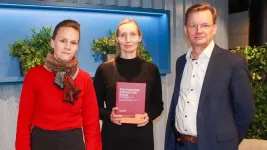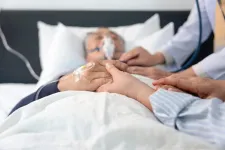(Press-News.org) Preeclampsia, a complication of pregnancy characterized by high blood pressure and high levels of protein in the urine (proteinuria), indicating damage to the kidneys or other organ damage, is the main cause of maternal-fetal death in Brazil and the runner-up worldwide. In a Brazilian study published in the journal PLOS ONE, the pattern of substances present in patient blood samples varied according to the severity of the preeclampsia concerned.
The findings from the study, which was supported by FAPESP, expand scientific knowledge of preeclampsia and the mechanisms whereby damage to the kidneys, lungs, liver and brain can occur, paving the way for future therapeutic strategies to prevent such damage.
The study sample comprised 173 pregnant women, divided into four categories: healthy; gestational hypertension; preeclampsia; and severe preeclampsia. Blood samples were submitted to metabolomic analysis for detection of metabolites (small molecules made when the body breaks down food, drugs, chemicals or its own tissue).
“In our investigation of what happened to the metabolism in these women, we succeeded in showing not only that it was altered but also that the patterns of alteration correlated with clinical variables. This is important because it opens up possibilities of a better understanding of preeclampsia, especially with regard to organ damage,” Valeria Cristina Sandrim, last author of the article and a professor at São Paulo State University’s Botucatu Institute of Biosciences (IBB-UNESP), told Agência FAPESP.
“The metabolites signal the metabolic pathways that are activated or inactivated, so we plan to conduct a second stage of the study in which we’ll look at why the metabolic alterations occur and how we can intervene pharmacologically.”
The blood samples were collected at the general and teaching hospital (Hospital das Clínicas) run by the University of São Paulo’s Ribeirão Preto Medical School (FMRP-USP). Researchers at UNESP São José do Rio Preto and the State University of Campinas (UNICAMP) performed the metabolomics portion of the study.
The study was the first to use hydrogen nuclear magnetic resonance spectroscopy (1H NMR) to identify metabolites in patients with severe preeclampsia and gestational hypertension. The multiuser equipment involved was purchased by FAPESP. The technique, which is non-destructive and does not require chemical manipulation of samples, provides accurate information about the molecular structure and concentration of all compounds present in the subject’s metabolism.
The researchers identified 19 metabolites and noted that 11 were different across the four groups. For example, the group with severe preeclampsia had higher levels of acetate, N,N-dimethylglycine, glutamine, alanine, valine and creatine than the group with gestational hypertension and the control group (healthy women).
A comparison between the groups with preeclampsia and severe preeclampsia showed that higher levels of N,N-dimethylglycine, glutamine, alanine and valine correlated with greater severity and that higher levels of specific metabolites, including N,N-dimethylglycine, alanine and valine were associated with increased blood pressure, worse obstetric outcomes, and poorer end-organ function, particularly renal and hepatic damage.
The metabolomic analysis of the women with preeclampsia also indicated heightened disturbances in nitrogen metabolism, methionine, and urea cycles.
“The exacerbated metabolic disturbances may point to renal impairment and hepatic dysfunction, as evidenced by elevated levels of creatine and alanine. These findings not only contribute novel insights but also provide a more comprehensive understanding of the pathophysiological mechanisms at play in cases of preeclampsia with signs of severity,” Sandrim said.
Translational science
The authors will now pursue two lines of research based on these results. First, they will conduct in vitro experiments involving cultured cells to find out which metabolic pathways are altered in preeclampsia patients and see if any suitable drugs exist for treating these alterations. The second line of research, which will be conducted with support from FAPESP as part of the doctoral candidacy of Julyane Kaihara, will investigate biomarkers for predicting the risk of preeclampsia.
“We will collect blood samples from another group of pregnant women before they’re diagnosed with preeclampsia to try to identify possible prior metabolic alterations. This is important because we know not all cities have maternity hospitals that specialize in control of hypertension, and if we can identify marker metabolites that serve to predict preeclampsia, it will be possible to monitor these at-risk pregnant women more effectively,” Sandrim said.
About FAPESP
The São Paulo Research Foundation (FAPESP) is a public institution with the mission of supporting scientific research in all fields of knowledge by awarding scholarships, fellowships and grants to investigators linked with higher education and research institutions in the state of São Paulo, Brazil. FAPESP is aware that the very best research can only be done by working with the best researchers internationally. Therefore, it has established partnerships with funding agencies, higher education, private companies, and research organizations in other countries known for the quality of their research and has been encouraging scientists funded by its grants to further develop their international collaboration.
END
Pattern of compounds in blood may indicate severity of gestational hypertension and preeclampsia
A study involving 173 pregnant women reached this conclusion. The findings expand scientific knowledge of the preeclampsia and the mechanisms whereby damage to the kidneys, lungs, liver and brain may occur.
2025-02-21
ELSE PRESS RELEASES FROM THIS DATE:
How does innovation policy respond to the challenges of a changing world?
2025-02-21
Researchers from the University of Vaasa, Finland, and Kent Business School, UK, have gathered insights on innovation policy, its current status and future perspectives in their new book “The Evolving Innovation Space”. The book offers research-based insights on how innovation can best be used to drive economic change and to find solutions to global problems.
– In a changing world, where geopolitical tensions are rising and artificial intelligence is gaining ground, innovation policy must also be reconsidered from new perspectives, says Helka Kalliomäki, one of the editors.
With digital ...
What happens when a diet targets ultra-processed foods?
2025-02-21
Most dietary programs are designed to help people achieve weight loss or adhere to U.S. nutrition guidelines, which currently make no mention of ultra-processed foods (UPFs). UPFs – like chips or candy – are the mass-produced, packaged products that contain little or no naturally occurring foods. Eating UPFs is strongly associated with increased risk of diseases and early death.
Because almost no existing programs focus specifically on reducing UPF intake, researchers from Drexel University’s College of Arts and Sciences designed an intervention that included a variety of tactics to target the uniquely problematic ...
University of Vaasa, Finland, conducts research on utilizing buildings as energy sources
2025-02-21
The University of Vaasa has received funding from Business Finland for the FlexiPower research and development project, which focuses on developing and commercializing the "Building as a Battery" (BaaB) solution. The project aims to find solutions that utilize existing building infrastructure as flexible energy sources.
The goal of the FlexiPower project is to develop and commercialize a solution that enables the dynamic response of building heating and cooling systems to the needs of the power system. This innovation offers a cost-effective and scalable solution for balancing the power grid without significant initial ...
Stealth virus: Zika virus builds tunnels to covertly infect cells of the placenta
2025-02-21
Infection with Zika virus in pregnancy can lead to neurological disorders, fetal abnormalities and fetal death. Until now, how the virus manages to cross the placenta, which nurtures the developing fetus and forms a strong barrier against microbes and chemicals that could harm the fetus, has not been clear. Researchers at Baylor College of Medicine with collaborators at Pennsylvania State University report in Nature Communications a strategy Zika virus uses to covertly spread in placental cells, raising little alarm in the immune system.
“The Zika virus, which is transmitted by mosquitoes, triggered an epidemic in the Americas that began in 2015 and ...
The rising tide of sand mining: a growing threat to marine life
2025-02-21
In the delicate balancing act between human development and protecting the fragile natural world, sand is weighing down the scales on the human side.
A group of international scientists in this week’s journal One Earth are calling for balancing those scales to better identify the significant damage sand extraction across the world heaps upon marine biodiversity. The first step: acknowledging sand and gravel (discussed as sand in this publication) – the world’s most extracted solid materials by mass – are a threat hiding in plain sight.
“Sand is a critical resource that shapes the built and ...
Contemporary patterns of end-of-life care among Medicare beneficiaries with advanced cancer
2025-02-21
About The Study: This study found persistent patterns of potentially aggressive care, but low uptake of supportive care, among Medicare decedents with advanced cancer. A multifaceted approach targeting patient-, physician-, and system-level factors associated with potentially aggressive care is imperative for improving quality of care at the end of life.
Corresponding Author: To contact the corresponding author, Youngmin Kwon, PhD, email youngmin.kwon@vumc.org.
To access the embargoed study: Visit our For The Media website at this link https://media.jamanetwork.com/
(doi:10.1001/jamahealthforum.2024.5436)
Editor’s Note: Please see the article ...
Digital screen time and nearsightedness
2025-02-21
About The Study: In this systematic review and dose-response meta-analysis, a daily 1-hour increment in digital screen time was associated with 21% higher odds of myopia (nearsightedness) and the dose-response pattern exhibited a sigmoidal shape, indicating a potential safety threshold of less than 1 hour per day of exposure, with an increase in odds up to 4 hours. These findings can offer guidance to clinicians and researchers regarding myopia risk.
Corresponding Author: To contact the corresponding author, Young Kook Kim, PhD, email md092@naver.com.
To access the embargoed study: Visit our For The Media website at this link https://media.jamanetwork.com/
(doi:10.1001/jamanetworkopen.2024.60026)
Editor’s ...
Postoperative weight loss after anti-obesity medications and revision risk after joint replacement
2025-02-21
About The Study: In this cohort study using a target trial emulation, a higher proportion of weight loss after initiating anti-obesity medications within 1 year was associated with a lower risk of 5-year and 10-year revision among patients with obesity undergoing joint replacement. These results suggest that anti-obesity medication use, with relatively safe and sustainable weight loss, may be an effective strategy for improving implant survivorship of hip and knee replacements in the obese population.
Corresponding Author: To ...
New ACS research finds low uptake of supportive care at the end-of-life for patients with advanced cancer
2025-02-21
Despite considerable efforts to improve the quality of end-of-life care in the United States, a new retrospective study led by American Cancer Society (ACS) researchers revealed that close to half of patients with advanced cancer received potentially aggressive care at the end-of-life at the expense of supportive care. The findings are out today in the Journal of the American Medical Association (JAMA) Health Forum.
“Even though clinicians and professional healthcare organizations have recommended early integration of supportive and ...
New frailty measurement tool could help identify vulnerable older adults in epic
2025-02-21
Investigators at Mass General Brigham have developed a tool that can identify older adults at increased risk of emergency healthcare needs, rehospitalization or death. The tool measured patient frailty, an aging-related syndrome, by integrating the health records of more than 500,000 individuals collected across multiple hospitals at Mass General Brigham. These findings, published in Journal of the American Geriatric Society, could help clinicians care for high-risk patients even without the availability of comprehensive primary care records.
“Frailty ...
LAST 30 PRESS RELEASES:
Why swearing makes you stronger
What prevents more cancer patients from enrolling in potentially life-saving clinical trials?
UK’s worst-case climate risks laid bare for lawmakers
A decline in churchgoing linked to more deaths of despair
TAMEST announces Maralice Conacci-Sorrell, Ph.D., UT Southwestern Medical Center, as 2026 Mary Beth Maddox Award & Lectureship Recipient
Global study to evaluate whether dengue outbreaks can be anticipated earlier
Chonnam National University researchers propose innovative voltage-loop control for power factor correction
Accelerating next-generation drug discovery with click-based construction of PROTACs
Detecting the hidden magnetism of altermagnets
$7M gift supports health research, engineering and athletics at UT San Antonio
NU-9 halts Alzheimer’s disease in animal model before symptoms begin
Hospitals acquired by real estate investment trusts associated with greater risk of bankruptcy, closure
City of Hope scientists study rare disorder to uncover mechanism and hormone regulation underlying fatty liver disease and sweet aversion
Your genes may influence gut microbiome of others, rat study shows
‘Personality test’ shows how AI chatbots mimic human traits – and how they can be manipulated
Global food systems driving twin crises of obesity and global heating
Osaka Medical and Pharmaceutical University researchers capture real-time molecular movies of enzyme catalysis
Could your genes influence the gut microbiome of others?
Clues to Alzheimer’s disease may be hiding in our ‘junk’ DNA
Study reveals that the body uses different sensors to detect cold in the skin and in internal organs
iPS cells from dish to freezer and back
Deep neural networks enable accurate pricing of American options under stochastic volatility
Collective risk resonance in Chinese stock sectors uncovered through higher-order network analysis
Does CPU impact systemic risk contributions of Chinese sectors? Evidence from mixed frequency methods with asymmetric tail long memory
General intelligence framework to predict virus adaptation based on a genome language model
Antibiotic resistance is ancient, ecological, and deeply connected to human activity, new review shows
Vapes, pouches, heated tobacco, shisha, cigarettes: nicotine in all forms is toxic to the heart and blood vessels
From powder to planet: University of Modena engineers forge a low-carbon future for advanced metal manufacturing
Super strain-resistant superconductors
Pre-school health programme does not improve children’s diet or physical activity, prompting call for policy changes, study finds
[Press-News.org] Pattern of compounds in blood may indicate severity of gestational hypertension and preeclampsiaA study involving 173 pregnant women reached this conclusion. The findings expand scientific knowledge of the preeclampsia and the mechanisms whereby damage to the kidneys, lungs, liver and brain may occur.



